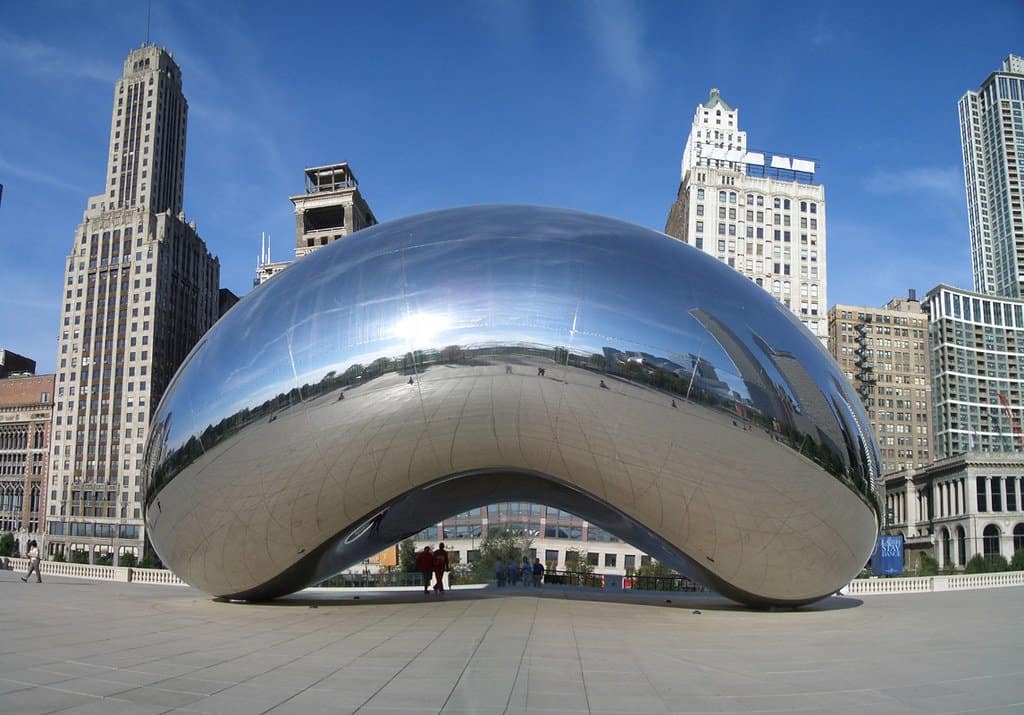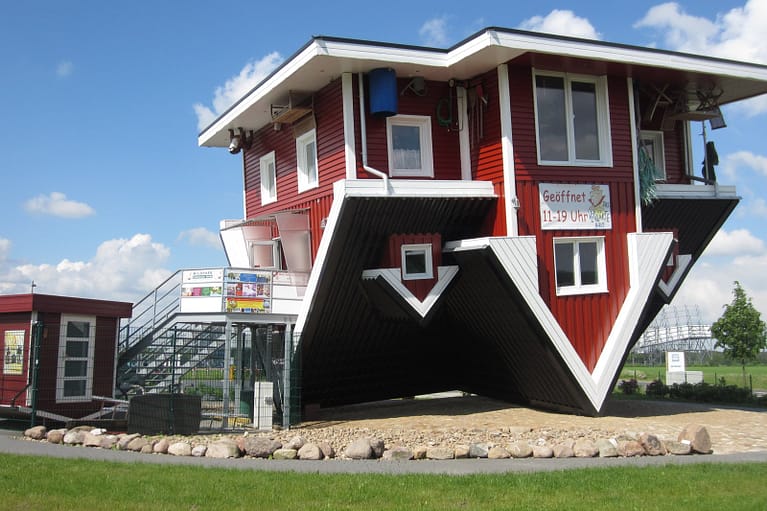Eccentric art installations captivate and challenge viewers worldwide, blending creativity, environment, and often a touch of whimsy. These installations, varying from grand sculptures to immersive environments, serve not just as visual spectacles but also as mediums for social and environmental commentary.
The Bean (Cloud Gate) – Chicago, USA

An iconic feature of Chicago’s Millennium Park, Cloud Gate, popularly known as ‘The Bean,’ is a monumental sculpture by Indian-born British artist Anish Kapoor. Completed in 2006, this 110-ton elliptical structure is made from a seamless series of highly polished stainless steel plates, which reflect the city’s skyline and the clouds above. The 33-foot high, 42-foot wide sculpture is renowned for its unique, mirror-like surface that distorts and magnifies the surroundings, offering an interactive experience as visitors walk around and under its 12-foot high arch.
The Headington Shark – Oxford, UK

The Headington Shark, officially titled “Untitled 1986,” is a rooftop sculpture in Oxford, England. Created by artist John Buckley for homeowner Bill Heine in 1986, the sculpture depicts a large shark appearing to crash head-first into the roof of a Victorian house. The 25-foot-long sculpture is made of fiberglass and was controversial at its installation, sparking debates about planning permissions and public taste. It’s a symbol of protest, representing impotence felt against seemingly arbitrary authority and a visual statement against nuclear war.
East Side Gallery – Berlin, Germany

The East Side Gallery in Berlin is one of the largest and most enduring open-air galleries in the world. This historic monument is a 1.3-kilometer-long section of the Berlin Wall that was transformed into an art space in 1990. Over 100 artists from across the globe have painted murals on the remnants of the wall, turning it into a symbol of freedom and a commemorative piece for peace and reconciliation. The artworks address various socio-political issues, making it a poignant reminder of the struggles for freedom.
Metalmorphosis – Charlotte, USA

Metalmorphosis is a striking kinetic sculpture created by Czech artist David Černý, located in Charlotte, North Carolina. Completed in 2007, this 25-foot-tall sculpture is made from layers of stainless steel plates that rotate independently, forming and reforming the head of a giant statue. The plates align to create a cohesive human face, which then disperses into abstract segments. The sculpture also features a fountain from the mouth, adding to its dynamic nature. Metalmorphosis is a representation of transformation and change, a fitting theme in the rapidly evolving cityscape.
The Underwater Museum – Cancun, Mexico

The Underwater Museum, known as MUSA (Museo Subacuático de Arte), is located in the waters surrounding Cancun, Isla Mujeres, and Punta Nizuc. Created by British sculptor Jason deCaires Taylor and other artists, it features over 500 life-sized sculptures placed underwater. These installations serve as artificial reefs, encouraging coral growth and providing habitat for marine life. The sculptures depict human figures in various poses and are made from pH-neutral materials, promoting marine biodiversity while offering a unique, surreal experience for divers and snorkelers.
The Rain Room – Various Locations

The Rain Room is an interactive art installation originally created by Random International, a London-based art collective. This immersive exhibit allows visitors to experience the sensation of being in the rain without getting wet. Sensors detect where visitors are standing, and the water falls everywhere except for their location, creating a dry zone amidst the downpour. This installation blurs the lines between art, technology, and nature, offering a meditative experience that explores human relationships with the environment and the controlling of natural elements.
The Vortex Waterfall – Various Locations

The Vortex Waterfall is a mesmerizing installation that creates a spiral of cascading water, giving the illusion of a swirling vortex. This type of installation can be found in various locations, with each artist bringing their own interpretation to the concept. The visual effect is achieved through precise engineering and water flow control, creating a hypnotic and ever-changing pattern. The waterfall not only serves as a stunning visual spectacle but also often carries a deeper meaning, symbolizing the continuous flow of time and the transformative power of nature.
The Upside Down House – Trassenheide, Germany

The Upside Down House in Trassenheide is an inventive architectural piece designed by Polish architects Klaudiusz Golos and Sebastian Mikiciuk. This quirky structure, completed in 2008, is a fully furnished house turned upside down, challenging the viewer’s perception of space and gravity. Everything inside, from furniture to household items, is secured to the ‘ceiling’, offering a unique, disorienting experience. This playful installation not only serves as a tourist attraction but also stimulates discussions about conventional architecture and the standard norms of living spaces.
The Floating Piers – Lake Iseo, Italy

“The Floating Piers” was a temporary art installation by the renowned Bulgarian-American artist Christo, set on Italy’s Lake Iseo in 2016. This visually striking project consisted of a three-kilometer walkway made of 220,000 high-density polyethylene cubes, covered with shimmering yellow fabric. For 16 days, it allowed visitors to walk across the water, connecting the mainland to the islands of Monte Isola and San Paolo. The artwork transformed the landscape, creating a surreal, tactile experience for visitors, and highlighting the natural beauty of the lake and the surrounding mountains.
The Singing Ringing Tree – Lancashire, UK

The Singing Ringing Tree is a unique wind-powered sound sculpture situated on the hills overlooking Burnley in Lancashire, England. Designed by architects Mike Tonkin and Anna Liu in 2006, this 10-foot tall sculpture is made of galvanized steel pipes, which harness the energy of the wind to produce a haunting, melodic sound. Resembling a tree bent by the wind, the sculpture’s aesthetic changes with the weather and time of day, creating a dynamic interaction with its natural surroundings and offering a sensory blend of art, music, and nature.
The Kelpies – Falkirk, Scotland

The Kelpies, located in The Helix park near Falkirk, Scotland, are two 30-meter tall horse-head sculptures, created by Scottish sculptor Andy Scott in 2013. Representing the mythical shape-shifting water spirits, these sculptures are engineering marvels, constructed from a complex framework of steel-clad plates. The Kelpies celebrate Scotland’s industrial heritage and the role of the horse in industry and agriculture. Illuminated at night, they create an imposing and magical presence, symbolizing transformation and endurance, and have become a significant cultural landmark.
The Seven Magic Mountains – Las Vegas, USA

The Seven Magic Mountains is a vibrant and large-scale public art installation near Las Vegas, created by Swiss artist Ugo Rondinone. Unveiled in 2016, it features seven towering stacks of brightly colored, painted boulders standing more than 30 feet high. Set against the stark desert background, these neon-hued totems create a stark contrast with the natural landscape. This work of art blends elements of human nature and the natural world, and represents a bridge between the urban and the wilderness, the artificial and the natural.
The Toilet Bowl Waterfall – Foshan, China

The Toilet Bowl Waterfall in Foshan, China, is an unconventional and thought-provoking installation created by Chinese artist Shu Yong using thousands of repurposed toilet bowls, sinks, and urinals. Assembled in 2013, these ceramic fixtures are stacked to form a cascading waterfall structure, symbolizing the excessive waste of resources and consumerism. This environmental art piece is not only a visual spectacle but also serves as a critical commentary on societal issues, reminding viewers of the importance of sustainability and environmental conservation.
The Big Rig Jig – Las Vegas, USA

The Big Rig Jig, created by American artist Mike Ross, is a monumental sculpture made from two repurposed tanker trucks. First unveiled at the Burning Man festival in 2007, it stands as a testament to creativity and repurposing. The trucks are bent and intertwined in an impossible-looking, gravity-defying dance, creating an impression of movement and dynamism. This sculpture challenges perceptions of large industrial objects, transforming them into a piece of art that speaks to themes of energy consumption and the complexities of modern industrial society.
The Hand in the Desert – Atacama Desert, Chile

“The Hand in the Desert” is a large-scale sculpture located in the Atacama Desert in Chile, created by Chilean sculptor Mario Irarrázabal. Unveiled in 1992, this surreal and imposing artwork features a giant hand emerging from the sand, reaching skyward. Standing 11 meters tall, it symbolizes human vulnerability and helplessness, contrasting starkly with the vastness of the desert. The sculpture’s isolated location adds to its dramatic impact, creating a sense of mystery and introspection for those who encounter it in the desolate landscape.
The Electric Ladyland – Amsterdam, Netherlands

The Electric Ladyland in Amsterdam is not just an art installation but also the world’s first museum of fluorescent art. Created by artist Nick Padalino, this immersive environment is a vibrant space filled with fluorescent minerals, rocks, and artwork that glow in the ultraviolet light. Visitors can experience a psychedelic, multi-sensory journey as they walk through this luminous, surreal landscape. This installation blurs the line between natural phenomena and artistic expression, offering a unique exploration of light and color.
The Mirror Cows – Various Locations

The Mirror Cows are a series of sculptures created by various artists, notably featured in cities like Edinburgh and New York. These life-sized cow sculptures are covered in mirrored surfaces, reflecting the surrounding environment and becoming a dynamic part of the urban landscape. They challenge the observer’s perception, blending art with the immediate surroundings and inviting interaction. Originally part of public art exhibitions, these mirrored cows have become symbols of creativity and playfulness in art, encouraging viewers to see the world from different perspectives.
The Crochet Coral Reef – Various Locations

The Crochet Coral Reef is a unique, ongoing project by sisters Margaret and Christine Wertheim and their Institute For Figuring. Started in 2005, this project combines mathematics, environmentalism, and handicraft. Participants crochet woolen corals, anemones, and other marine forms, mimicking the structure of natural coral reefs using hyperbolic geometry. This collaborative art installation serves as both a stunning visual spectacle and a powerful statement on the destruction of coral reefs due to global warming and oceanic pollution.
The Forever Bicycles – Toronto, Canada

“The Forever Bicycles” is an awe-inspiring installation by renowned Chinese artist Ai Weiwei, displayed at Toronto’s Nathan Phillips Square. Featuring over 3,000 interconnected bicycles, the sculpture creates a three-dimensional structure that plays with space and perception. The artwork, part of Ai’s ongoing exploration of the bicycle as a symbol of Chinese culture and social change, forms a labyrinthine, visually complex formation, representing both the collective movement and the individual within the society.

